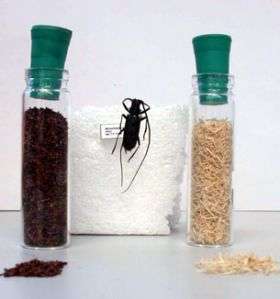Tyler Cobb says these beetles and their droppings are an integral part of a forest's recovery following a fire.
Armed with a pair of tweezers and a handful of beetle droppings, University of Alberta forestry graduate Tyler Cobb has discovered why the bug-sized dung is so important to areas ravaged by fire.
Cobb, now the curator of Invertebrate Zoology at the Royal Alberta Museum, studied the burned-out area of Chisholm, the northern Alberta hamlet which was partially lost to wildfire during the blazing summer of 2001. By studying a certain species of fire-loving beetles hard at work in the burned and decaying trees, he was able to determine that the insects' droppings play a vital role in replenishing soil nutrients that help plants regenerate after a fire.
Cobb, while earning his PhD in the U of A Faculty of Agricultural, Life and Environmental Sciences, worked with about 10 grams of beetle dung - 50 to 60 beetles can produce just a handful - over two years, slowly teasing it apart with tweezers and chemically analyzing the contents and using it for experiments to pinpoint the benefits to soil.
Beetle droppings - known in the scientific world as frass - are crucial to forests recovering from fire. The tiny piles of droppings, found at the bases of trees, resemble cones of sawdust, and they help nourish the forest floor by increasing microbial activity in the soil. This process can also determine which kinds of trees grow back.
"This means that rather than being considered a pest or a nuisance, these beetles are in fact very important to helping burned forests recover," Cobb said. He is concerned, though, because salvage logging is taking the beetles out of the forest before they can do their job. The insects lay their eggs in the dead trees, and the larvae are subsequently destroyed when the wood is processed at sawmills.
"That population is being removed from the salvage site and that takes away the mechanism by which the nutrients are returned to the soil."
Salvage logging should be delayed after a fire to allow the beetles to complete their life cycle, Cobb said. "In theory, if you delayed logging for two years, these beetle populations could survive." Another option, he added, is to leave some burned timber - perhaps 10 to 25 per cent - as-is.
Though he intensively studied the frass of only one beetle species, Cobb says that dead wood-associated beetles are found throughout the world, and that without their valuable back-end contributions, forests damaged by fire and other disturbances will be worse off.
"Forest management activities that threaten these species could have widespread ecological impacts. Wherever you've got forest you've got a beetle community essentially dedicated to this decomposition process, which is critical to the overall health of the forest."
Source: University of Alberta
























